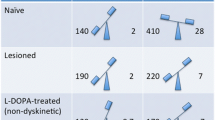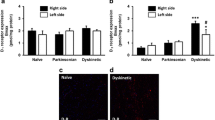Summary
Dopamine receptors have been characterized by the use of radiolabelled dopamine agonists and antagonists. Using ibotenic acid induced lesions of the striatum, evidence was obtained that3H-N-propylnorapomorphine (3H-NPA) binding sites and3H-bromocriptine binding sites are located both on intrastriatal nerve cells and on extrinsic nerve terminals probably mainly originating in the cerebral cortex. Development of dopamine receptor super-sensitivity as evaluated in 6-hydroxydopamine lesioned rats was associated with an 50% increase in the number of3H-NPA binding sites in the striatum. Furthermore, one year following the 6-hydroxydopamine induced lesion of the dopamine pathways two binding sites for3H-NPA could be demonstrated in the striatum. However, at this time interval the total number of3H-NPA binding sites was not increased. The functional significance of these two binding sites for3H-NPA in the striatum is unknown, but they are probably coupled to the biological effector in view of the marked behavioural supersensitivity demonstrated in these old animals.
The dopamine receptor agonists and especially the dopaminergic ergot derivatives have been characterized by studying their affinities for3H-bromocriptine,3H-spiperone,3H-ADTN and3H-NPA binding sitesin vitro. It is suggested that the Ki ratios for agonist and antagonist radioligands may be one useful way to characterize the agonist-antagonist character of the drug. Another important method is to study the effects of dopamine receptor agonists on the specificin vivo binding of3H-spiperone and3H-NPA. The correlation analysis of DA agonist affinities for the four radioligands of DA receptors used in the present study give evidence for the existence of at least 3 types of DA receptors.
Actions of dopaminergic ergot drugs have been evaluated at supersensitive dopamine receptors. The findings suggest that the shift to the left of the threshold dose to activate supersensitive dopamine receptors could be due to a lowering of the stereoselectivity of agonist interaction at the dopamine agonist sites of supersensitive dopamine receptors. Such a change may explain the highly preferential action of CF 25-397 at supersensitive dopamine receptors, since its affinity for3H-NPA binding sites was not increased in the present experiments.
In agreement with previous work, evidence have also been presented that prolonged treatment with a potent dopaminergic drug, pergolide, can produce a down regulation of normal dopamine receptors by reducing the density of such receptors.
Evidence has also been presented that CCK-8 and the desulphated CCK-8 (10−6 M) canin vitro reduce the number of3H-NPA binding sites in the striatum. These results indicate that cholecystokinin peptides via activation of cholecystokinin receptors can regulate the movements of the3H-NPA binding sites across the plane of the membrane in such a way as to make them less available to the external surface of the membrane. Thus, cholecystokinin peptides and other neuropeptides may represent important neuromodulators and trophic factors in the dopamine synapses of the brain.
Similar content being viewed by others
References
Agnati, L. F., Fuxe, K.: On the mechanism of the antiparkinsonian action of l-DOPA and bromocriptine: A theoretical and experimental analysis of dopamine receptor sub- and supersensitivity. J. Neural Transm., Suppl. 16, pp. 69–81. Wien-New York: Springer. 1980.
Bennett, J. P., Snyder, S. H.: Serotonin and lysergic acid diethylamide binding in rat brain membranes: Relationship to postsynaptic serotonin receptors. Mol. Pharmacol.12, 373–389 (1976).
Closse, A., Frick, W., Hauser, D., Sauter, A.: Characterization of3H-bromocriptine binding to calf caudate membranes. In: Psychopharmacology and Biochemistry of Neurotransmitter Receptors. New York: Elsevier/North-Holland (to be published, 1981).
Creese, I., Padgett, L., Fazzini, E., Lopez, F.:3H-N-n-propylnorapomorphine. A novel agonist ligand for central dopamine receptors. Eur. J. Pharmacol.56, 411–412 (1979).
Creese, I., Prosser, T., Snyder, S. H.: Dopamine receptor binding: Specificity, localization and regulation by ions and guanyl nucleotides. Life Sci.23, 495–500 (1978).
Creese, I., Schneider, R., Snyder, S. H.:3H-spiroperidol labels dopamine receptors in pituitary and brain. Eur. J. Pharmacol.46, 377–381 (1977).
Creese, I., Snyder, S. H.: Dopamine receptor binding of3H-ADTN (2-amino-6, 7-dihydroxy-1,2,3,4-tetrahydroaphtalene) regulated by guanyl nucleotides. Eur. J. Pharmacol.50, 459–461 (1978).
Flückiger, E., Vigouret, J. M.: Drugs, dopamine and pituitary secretion. In: Medical Chemistry VI (Proc. 6th Internat. Symp. Med. Chemistry, Brighton, U. K., 1978), pp. 469–477. Oxford: Cotswold Press Limited. 1979.
Fuxe, K., Calne, D. B.: Wenner-Gren Center International Symposium Series, Vol.31: Dopaminergic Ergot Derivatives and Motor Function. Oxford: Pergamon Press. 1979.
Fuxe, K., Fredholm, B. B., Agnati, L. F., Corrodi, H.: Dopamine receptors and ergot drugs. Evidence that an ergolene derivative is a differential agonist at subcortical limbic dopamine receptors. Brain Res.146, 295 to 311 (1978).
Fuxe, K., Hall, H., Köhler, C.: Evidence for an exclusive localization of3H-ADTN binding sites to postsynaptic nerve cells in the striatum of the rat. Eur. J. Pharmacol.58, 515–517 (1979 a).
Fuxe, K., Köhler, C., Agnati, L. F., Ögren, S.-O.: Studies on postsynaptic dopamine receptors using a dopamine agonist ligand,3H-N-propylnorapomorphine. Neurosci. Lett., Suppl. 5, Abstract, p. 98 (1980 a).
Fuxe, K., Schwarcz, R., Agnati, L. F., Fredholm, B., Ögren, S.-O., Köhler, C., Gustafsson, J.-Å.: Action of ergot derivatives at dopamine synapses. In: Wenner-Gren Center International Symposium Series, Vol. 31: Dopaminergic Ergot Derivatives and Motor Function, p. 141. Oxford: Pergamon Press. 1979 b.
Fuxe, K., Ögren, S.-O., Fredholm, B., Agnati, L. F., Hökfelt, T., Perez de la Mora, M.: Possibilities of a differential blockade of central monoamine receptors. In: Rhinencéphale Neurotransmetteurs et Psychoses (Symposium Bel-Air V, Geneve, 1976), pp. 253–289. Geneve: Georg & Cie. 1977.
Fuxe, K., Ögren, S.-O., Hall, H., Agnati, L. F., Andersson, K., Köhler, C., Schwarcz, R.: Effects of chronic treatment with l-sulpiride and haloperidol on central monoaminergic mechanisms. In: Long-Term Effects of Neuroleptics (Adv. Biochem. Psychopharmacol., Vol. 24), p. 193. New York: Raven Press. 1980 b.
Goldstein, M., Calne, D. B., Lieberman, A., Thorner, M. O.: Ergot Compounds and Brain Function: Neuroendocrine and Neuropsychiatric Aspects. New York: Raven Press. 1980 a.
Goldstein, M., Lew, J. Y., Engel, J., Nakamura, S., Battista, A.: The dopaminephillic properties of ergoline derivatives. In: Wenner-Gren Center International Symposium Series, Vol.31: Dopaminergic Ergot Derivatives and Motor Function, p. 253. Oxford: Pergamon Press. 1979.
Goldstein, M., Lew, J. Y., Sauter, A., Lieberman, A.: The Affinities of Ergot Compounds for Dopamine Agonist and Dopamine Antagonist Receptor Sites, Ergot Compounds and Brain Function, p. 75. New York: Raven Press. 1980 b.
Greenberg, D. A., U'Prichard, D. C., Snyder, S. H.: Alpha-noradrenergic receptor binding in mammalian brain: differential labeling of agonist and antagonist states. Life Sci.19, 69–76 (1976).
Hall, H., Thor, L.: Evaluation of a semiautomatic filtration technique receptor binding studies. Life Sci.24, 2393–2400 (1979).
Hart, H. E.: Determination of equilibrium constants and maximum binding capacities in complex in vitro systems. Bull. Math. Biophysics27, 87–98 (1965).
Hökfelt, T., Rehfeld, J. F., Skirboll, L., Ivemark, B., Goldstein, M., Markey, K.: Evidence for coexistence of dopamine and CCK in mesolimbic neurones. Nature285, 476–478 (1980).
Kebabian, J. W., Calne, D. B.: Multiple receptors for dopamine. Nature277, 93–96 (1979).
Keller, R., Oke, A., Mefford, I., Adams, R. N.: Liquid Chromatographic analysis of catecholamines-routine assay for regional brain mapping. Life Sci.19, 995–1004 (1976).
Köhler, C., Fuxe, K., Ross, S. B.: Regional in vivo binding of3H-N-propylnorapomorphine in the mouse brain. Evidence for labelling of central dopamine receptors. Eur. J. Pharmacol, (submitted, 1981).
Köhler, C., Fuxe, K., Ögren, S.-O., Agnati, L. F.: Evidence forin vivo binding of apomorphine and bromocriptine to receptor sites not labelled by3H-spiperone. Eur. J. Pharmacol.58, 339–340 (1979).
Laduron, P. M., Janssen, P. F. M., Leysen, J. E.: Spiperone: a ligand of choice for neuroleptic receptors. 2. Regional distribution andin vivo displacement of neuroleptic drugs. Biochem. Pharmacol.27, 317–321 (1978).
Lew, J. Y., Goldstein, M.: Dopamine receptor binding for agonist and antagonists in thermal exposed membranes. Eur. J. Pharmacol.55, 429–430 (1979).
Leysen, J. E.:3H-Apomorphine receptors in various rat brain regions: a study of specific and nonspecific binding and the influence of chronic neuroleptic treatment. In: Long-Term Effects of Neuroleptics (Adv. Biochem. Psychopharmacol., Vol. 24), p. 123. New York: Raven Press. 1980.
Loew, D. M., Vigouret, J.-M., Jaton, A.-L.: Neuropharmacology of ergot derivatives. In: Dopaminergic Ergot Derivatives and Motor Function, p. 129. New York: Pergamon Press. 1979.
Markstein, R., Herrling, P. L., Bürki, H. R., Asper, H., Ruch, W.: The effect of bromocriptine on the adenylate cyclase and the catecholamine metabolism of the rat brain. J. Neurochem.31, 1163–1172 (1978).
McDermed, J. D., McKenzie, G. M., Freeman, H. S.: Synthesis and dopaminergic activity of (±)−, (+, and -)-2-dipropylamino-5-hydroxy-1, 2, 3, 4-tetrahydronaphthalene. J. Med. Chem.19, 547–549 (1976).
O'Brien, R. D.: The Receptors: A Comprehensive Treatise. New York: Plenum Press. 1979.
Rinne, U. K., Koskinen, V., Lönnberg, P.: Neurotransmitter receptors in the parkinsonian brain. In: Parkinson's Disease: Current Progress, Problems and Management, p. 93. Amsterdam: Elsevier/North-Holland Biomedical Press. 1980.
Rosenthal, H. E.: A graphic method for the determination and presentation of binding parameters in a complex system. Anal. Biochem.20, 525–532 (1967).
Saito, A., Sankaran, H., Goldfine, I. D., Williams, J. A.: Cholecystokinin receptors in the brain: characterization and distribution. Science208, 1155–1156 (1980).
Schwarcz, R., Fuxe, K., Agnati, L. F., Gustafsson, J.-Å.: Effects of bromocriptine on3H-spiroperidol binding sites in rat striatum. Evidence for actions of dopamine receptors not linked to adenylate cyclase. Life Sci.23, 465–470 (1978).
Spano, P. F., Saiani, L., Memo, M., Trabucchi, M.: Interaction of dopaminergic ergot derivatives with cyclic nucleotide system. In: Ergot Compounds and Brain Function: Neuroendocrine and Neuropsychiatric Aspects, p. 95. New York: Raven Press. 1980.
Titeler, M., Seeman, P.: Selective labelling of different dopamine receptors by a new agonist3H-ligand:3H-N-propylnorapomorphine. Eur. J. Pharmacol.56, 291–292 (1979).
Ungerstedt, U.: 6-Hydroxydopamine induced degeneration of central monoamine neurons. Eur. J. Pharmacol.5, 107–110 (1968).
U'Prichard, D. C.: Multiple CNS receptor interactions of ergot alkaloids: affinity and intrinsic activity analysis inin vitro binding systems. In: Ergot Compounds and Brain Function: Neuroendocrine and Neuropsychiatric Aspects, p. 103. New York: Raven Press. 1980.
Vanderhaeghen, J. J., Lotstra, F., De Mey, J., Gilles, C.: Immunohistochemical localization of cholecystokinin- and gastrin-like peptides in the brain and hypophysis of the rat. Proc. Nat. Acad. Sci. U. S. A.77, 1190–1194 (1980).
Ögren, S.-O., Köhler, C., Fuxe, K., Ängeby, K.: Behavioural effects of ergot drugs. In: Wenner-Gren Center International Symposium Series, Vol. 31: Dopaminergic Ergot Derivatives and Motor Function, p. 187. Oxford: Pergamon Press. 1979.
Author information
Authors and Affiliations
Rights and permissions
About this article
Cite this article
Fuxe, K., Agnati, L.F., Köhler, C. et al. Characterization of normal and supersensitive dopamine receptors: Effects of ergot drugs and neuropeptides. J. Neural Transmission 51, 3–37 (1981). https://doi.org/10.1007/BF01664003
Received:
Issue Date:
DOI: https://doi.org/10.1007/BF01664003




